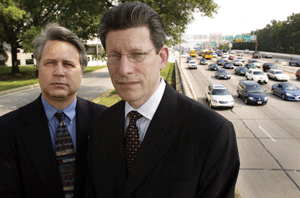When Hurricane Isabel lashed the Mid-Atlantic states last month, downed trees, power lines and widespread flooding pinched off roads and highways throughout the region.In Maryland, state highway officials monitored the road closures and eased traffic delays using a $90 million statewide intelligent transportation system known as the Coordinated Highways Action Response Team, or CHART. Deployed more than a decade ago, the system has since been enhanced through work done by Computer Sciences Corp. of El Segundo, Calif.Using CHART, state transportation and public safety officials reduced the number of road closures from Isabel from more than 200 at the storm's height to less than 10 three days later, according to the Maryland State Highway Administration."We put what we had developed to its greatest test," said Michael Zezeski, director of CHART and Intelligent Transportation Systems Development with the Maryland State Highway Administration. "CHART allowed us to facilitate communications [during the hurricane] and know where our resources were."[IMGCAP(2)]While traffic and incident management systems such as CHART have become common, industry officials said they expect to see more state and local governments expand their use of intelligent transportation technologies.Some cities are looking to build systems that support the transportation infrastructure, help manage traffic flow and ease congestion. Such systems also could gather data on traffic accidents, leading to construction projects that correct road problems. Municipalities also are using intelligent transportation systems to electronically collect bridge and highway tolls and check commercial vehicle weight and permits. Gartner Inc., a Stamford, Conn.-based market research firm, estimated spending on information technology hardware, software and solutions for transportation by state and local governments will grow from $6.8 billion in 2003 to $7.8 billion in 2006. Despite these predictions, state transportation departments and motor vehicle administrations are feeling the same financial pinch as other state agencies. The rate of growth in the transportation sector has slowed from an annual rate of 6.5 percent in 2002 to 4.5 percent over the next three years, according to Gartner.Analysts and industry officials said that state and local governments can no longer finance new projects using transportation trust funds, which are established from fuel taxes, motor vehicle taxes and federal aid to cover everything from operations and maintenance to capital projects. They'll need to explore new ways to finance transportation projects. Some governments are already using toll fees or general tax revenues to fund highway projects. Others are considering leasing traffic management facilities built and paid for by the private sector.[IMGCAP(3)]"In the past, these concepts have been dead on arrival," said Michael Huerta, senior vice president and managing director for transportation systems with Affiliated Computer Services Inc. of Dallas, referring to the expansion of toll programs. "Now they're the centerpieces of what you will see in the future." SAFETY FIRSTIt's hard not to empathize with the utopian values of those who advocate and promote intelligent transportation systems."We see a time when people and goods are moving without fatality, without injury and without delay on systems that are safe, effective and integrated," said Neil Schuster, president of the Washington-based Intelligent Transportation Society of America.However, not all technology officials share Schuster's optimism. Virginia Secretary of Technology George Newstrom said that intelligent transportation systems, also known as ITS, have not lived up to their initial promise.When the concept was first introduced about 20 years ago, Newstrom said, ITS supporters claimed that by the start of the 21st century, motorists would be riding in cars that drove themselves. Driving a car would be no more strenuous than riding a bus, train or plane. Still, progress is being made, said Leon Walden, a transportation engineer specialist with the Kentucky Transportation Cabinet."We are trying to mainstream ITS so it is not regarded as a [standalone] project, but just like a construction project where you would put in a culvert or a traffic signal," he said.At press time, Congress was considering the six-year surface transportation reauthorization legislation, which is up for its third renewal. In its proposal for the Safe, Accountable, Flexible and Efficient Transportation Equity Act, also known as SAFETEA, the Bush administration has requested about $1.7 billion for ITS. The administration's request is a 20 percent increase over the last reauthorization. While lawmakers work on the final reauthorization bill, they are expected to pass a six-month extension of the present surface transportation law that will continue funding at current levels. H.T. Vaught, managing director of transportation solutions for state and local government with BearingPoint Inc. of McLean, Va., said the administration's proposal for surface transportation focuses heavily on safety, and would provide $600 million worth of incentives for safety-oriented programs, such as accident tracking systems. These systems track the cause of traffic accidents and provide data to state and local transportation officials for construction projects to make roads and highway safer, he said. What's more, the new surface transportation legislation will provide funding for various ITS demonstration projects, intelligent highways, and the integration of highway networks with on-board systems in passenger vehicles, he said. Huerta agreed that safety is the primary focus of ITS funding. In the past federal, state and local government was focused heavily on incident management, but the view is widening to include preventing road-clogging smashups.These kinds of initiatives indicate that the federal ITS program has matured, Huerta said. HOMELAND SECURITY Although government officials initially looked to ITS to solve traffic problems, they now see important links to public safety."Probably the most compelling reason for spending money on ITS will stem from homeland security considerations," said Ray Bjorklund, vice president of market intelligence with market research firm Federal Sources Inc., McLean, Va. For example, ITS can significantly enhance response time to transportation-related accidents and disasters, he said. This happens not only because of transmissions from cameras and other devices, but also because agencies are sharing information, collaborating on decisions and coordinating responses. Furthermore, ITS is important in boosting state and local government preparedness through modeling and response planning, he said. An obvious overlap between ITS and homeland security that has not realized its potential is the use of remote cameras, said Rishi Sood, principal analyst with Gartner Dataquest, Stamford, Conn. Transportation and public safety officials could collaborate to monitor transportation infrastructure, such as roads, bridges, seaports and airports."There's a huge homeland security play that has been under the radar, and that is the increased focus on remote monitoring through the installation of cameras at key locations around the city," Sood said.[IMGCAP(4)]The $24 million emergency command center that Los Angeles-based Northrop Grumman Corp. designed and constructed for Austin-Travis County, Texas, illustrates the trend toward merging transportation and public safety operations, said Bruce Bauer, manager of transportation systems for Northrop Grumman. The center not only serves as the operations center for the Texas Department of Transportation in the region, but also houses the city's 911 emergency dispatch operations, he said.Northrop Grumman also operates traffic and incident management systems for the Cincinnati-Northern Kentucky region and for the Louisville, Ky.-Southern Indiana region. Although the systems are not located with other public safety agencies, these regions are considering the idea as part of their long-range plans. And even if the traffic management and public safety facilities are physically separate, their systems can be integrated to enable collaboration, Bauer said. For example, the 911 emergency dispatchers in Louisville view the traffic management cameras via a traveler information Web site also available to the public, said Mike Pekham, Northrop Grumman's transportation systems business development manager.The first two of four major upgrades planned to Maryland's CHART system by CSC have made it possible for the highway administration to give other government users access to the system, said Richard Dye, CHART system administrator for the State Highway Administration. In 1998, CSC was the first recipient of several multiyear task orders -- using standard, statewide systems integration contracts -- to improve and expand the functionality of the CHART incident response software, as well as to redesign its communications infrastructure, Dye said.The software and communications upgrades have enabled 40 operational centers, including many first responders, to access the system from their respective locations throughout the state, he said. The company has received more than $25 million for its work on CHART to date, said Michael Madden, CSC's CHART program manager. While the states' fiscal crisis has slowed the business opportunity for the time being, CSC remains poised to take advantage of similar opportunities as they develop, Madden said. Using open systems for CHART means the company could migrate the solution to other states, he said. While there are few opportunities for similar statewide ITS implementations, state and local governments are hiring contractors for business process re-engineering on construction projects, to implement ITS on major construction projects and to develop regional architectures that are consistent with the national ITS infrastructure established by the U.S. Transportation Department.For example, Northrop Grumman has projects under way in several cities, including Wichita, Kan., Cleveland and Lexington, Ky., to develop ITS architectures along national ITS standards, Bauer said. These projects typically range from $500,000 to $1 million, he said. E-TOLLS: ALL THE RAGEA decade ago, not a single state in the nation had a full-scale electronic toll collection, or ETC, project, said Gartner's Sood. There were just a few scattered pilot projects."Now electronic toll collection projects are the rage across the nation," he said.ACS and Raytheon Co. of Lexington, Mass., are leading providers of ETC and related services in North America and overseas.ACS has more than 5 million customers in nine states, including California, Delaware, Maryland, New Jersey, New York and South Carolina. The company's E-ZPass program in the northeastern United States includes New Jersey and New York, which are the two largest ETC programs in the nation, Huerta said.ACS is now establishing companion programs for E-ZPass. For example, E-ZPass customers can use their accounts to pay for airport parking in the New York City area, Huerta said.Mike Prout, president of highway transportation management systems for Raytheon, said there is a movement afoot in the United States to refrain from building new toll plazas in favor of multilane, "open-road" collection systems that allow passengers to drive at highway speed past sensors that automatically record the toll charges. Raytheon has projects outside the United States for open-road ETC systems, he said. One is Highway 407, an express toll route in Toronto, and another is the Cross-Israel Highway Electronic Toll and Traffic Management System. The Israel deal brought $64.5 million in revenue. ACS also operates a computerized system known as PrePass, which allows state officials to monitor the credentials and weights of trucks traveling within or across state lines. More than 225,000 trucks are equipped to use the PrePass system at 238 sites in 24 states, Huerta said.Both ACS and BearingPoint have found new opportunities helping states issue permits for oversize and overweight trucks. ACS won a five-year, $4.7 million contract earlier this year from the Florida Transportation Department to operate the state's permitting office for oversize and overweight trucks, Huerta said. BearingPoint built and deployed a Web-based permit routing and analysis system for the Pennsylvania Department of Transportation designed to substantially reduce processing time. Thom Rubel of the Meta Group said ITS has not reached its full potential in helping state and local governments deal with transportation and regulatory issues. Rubel, who is vice president of government strategies for the Stamford, Conn., market research firm, said ITS can play a substantial role in resolving such thorny issues as traffic congestion and air quality improvement. "ITS needs to look at where the benefits are to drive down costs and achieve compliance with regulatory programs, because that is what will attract states, he said. Staff writer William Welsh can be reached at wwelsh@postnews weektech.com.XXXSPLITXXX-One need look no further than new road and bridge construction to see how intelligent transportation systems have become an integral part of every new major transportation project. From coast to coast, highway officials are including ITS into project designs not only to lessen the inconvenience to motorists affected by the construction, but also to ensure safety during and after the project.The construction of two spans of the new Woodrow Wilson Bridge to carry traffic on Interstate 95 over the Potomac River between Maryland and Virginia will affect a 7.5-mile stretch that includes the approaches to the bridge as well as the 1.1-mile drawbridge itself, said John Undeland, a project spokesman. The general contractor on the 11-year, $2.6 billion project is New York-based planning and engineering firm Parsons Brinkerhoff. Although Virginia let the contract, Washington, Maryland and the U.S. Transportation Department cosponsor it. The first phase of the ITS implementation will occur early next year when highway engineers install closed-circuit television cameras and variable message signs near the U.S. Route 1 interchange south of the bridge. The cameras and signs will be used primarily to inform motorists of traffic incidents and congestion south of the bridge, Undeland said. "The project agencies involved made a strategic decision to accelerate deployment of ITS before major disruptions of intensifying construction occur," he said. A wider rollout of ITS will come when the new spans open in 2006 and 2008, said Jeffrey Archer, the project's ITS manager. In addition to closed-circuit cameras and variable message signs, the final ITS implementation will include a roadway weather information system, traffic detectors and wired and wireless communications, Archer said. The drawbridge control tower, which will be placed between the two spans, will contain an ITS work station that allows the operator to post information on variable message signs via the Maryland Statewide Operations Center, and control the cameras that monitor the shipping channel. The total cost for ITS on the project will be about $10 million, he said. While some ITS infrastructure construction projects employ portable systems in the work zones to control the cameras and other equipment, the Woodrow Wilson Bridge Project will leverage existing ITS support from the Maryland Statewide Operations Center and Virginia's Smart Traffic Center, Archer said. He said the roadway construction contractors will install the equipment, and that the systems integrators under contract with Maryland and Virginia will integrate it into existing statewide and regional ITS systems. Computer Sciences Corp. of El Segundo, Calif., and PB Faradyne of Rockville, Md., will handle the systems integration for Maryland and Virginia, respectively, he said. "All of our field devices will be integrated into those existing systems," Archer said.XXXSPLITXXX-Transportation Management Unknown $30 million Dec. 8 The Delaware DOT will procure hardware, software and services for its integrated transportation management system project on a 250-mile stretch of Interstate 95. The project will likely result in several solicitations. Advanced Traffic Management SystemUnknown $250,000 Undetermined The Kansas DOT is planning to issue RFPs for several aspects of an advanced traffic management system initiative for the Wichita area. The system will combine freeway management, arterial management and emergency communications into one system to aid the metro area in responding to incident-related congestion. ITS Corridor Implementation Unknown $1 million December The Nevada DOT is planning to release an RFP for a contractor to assist with implementing an ITS system on the Interstate 80 corridor in California, Nevada and Utah. Special Statewide ITS SystemUnknown Undetermined UndeterminedThe New Hampshire DOT has a potential requirement for deployment and integration of a statewide transportation system. The work may include various ITS technologies along several corridors as well as roadway design and structural design. The services will include recommendations for hardware and software and the ability to provide technical inspections of installations as required. ITS Architecture Implementation Unknown $250,000 Undetermined The agency will request proposals for an ITS implementation. Several solicitations are likely to flow from this project, including advanced traffic management systems, advanced traveler information systems, commercial vehicle operations, advanced public transportation systems, advanced rule transportation systems and advanced vehicle control and safety systems. Multi-agency Transportation System Plan Development Nine months$100,000 Fourth quarter 2003 The New York City DOT will issue an RFP seeking a contractor to provide technical services for developing detailed designs for an integrated, multi-agency transportation system network. Intelligent Transportation System Plan Implementation Unknown $250,000 UndeterminedThe New York DOT may release a request for proposal for implementation of its ITS strategic plan for the department's statewide ITS program. Specific tasks will be related to planning, integration, national and state standards and architecture, outreach and other technical and policy issues. ITS/Commercial Vehicle Operations Implementation Unknown$500,000 Undetermined The South Carolina departments of Public Safety and Transportation, the South Carolina Trucking Association and the Federal Highway Administration's Office of Motor Carriers have entered into a memorandum of agreement to develop a business plan for deploying ITS and commercial vehicle operations technologies in the state. ITS system for I-81 CorridorUnknown $100,000 UndeterminedThe Virginia DOT intends to establish a contract for a systems integrator to manage the department's ITS along the Interstate 81 corridor. The development of an ITS program will coincide with extensive, long-term reconstruction of most of the interstate.Sources: Federal Sources Inc. and Input Inc.
Steve Kuciemba (left) and Neil Schuster of the Intelligent Transportation Society of America said that even in a tight economy, Congress will continue to fund intelligent transportation.
Henrik G. de Gyor
Michael Zezeski of the Maryland State Highway Administration said the state's traffic management system passed "its greatest test" during Hurricane Isabel by facilitating communications and identifying resources.
Henrik G. de Gyor
As state and local governments explore new ways to finance transportation projects, officials are increasingly turning to toll programs, said Michael Huerta of ACS, which operates the E-ZPass system in the Northeast.
Olivier Douliery
Program manager Scott Evans (left) works with the staff of Northrop Grumman's advanced traffic management system in Cincinnati. The system improves incident response time and helps ease area congestion.
Northrop Grumman






